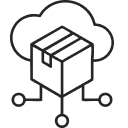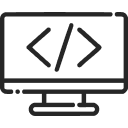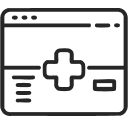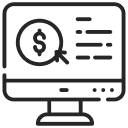Big Data Analytics: Unleashing the Power of Data
- January 23, 2024
-
3358 Views
- by Ishan Vyas

Big data analytics is the collection of processes and advanced technologies used by organizations to adopt the data-driven decision-making model. Here, we’ll discuss how big data analytics can unleash the power of data and help a business to achieve its goals.
The data-driven decision-making model is a powerful way to maintain business competitiveness, improve customer satisfaction, and increase revenue. In today’s world, businesses rely on artificial intelligence tools to collect, store, and analyze large volumes of data. Big data analytics offers the necessary speed, efficiency, and agility to harness its data and make effective decisions in real-time.
As per the statistics, the big data analytics market will reach $103 billion in 2023. According to NewVantage’s Data and AI Executive survey, 97.2% of the major organizations globally are investing in big data, artificial intelligence tools, and Ad Intelligence Tools that help them track digital campaign effectiveness and refine ad strategies.
But how does big data analytics help a business unlock the power of data? What benefits does it offer to an enterprise? Let’s find out in this blog.
What is Big Data Analytics?
Big data analytics is the process of collecting, cleaning, sorting, arranging, and analyzing vast volumes of data. It is used to detect complex patterns, trends, hidden correlations, and other insights. The insights help the management and employees make faster, better, and more proactive decisions to boost the business.
Big data analytics requires advanced tools and algorithms. AI, ML and Process mining are used to analyze large datasets and derive insights that are not possible through traditional analytical techniques.
How Big Data Analytics Works?
Big data analytics is a series of automated and semi-automated tasks that make an organization’s big data operational and useful for decision-making.
-
Data Collection
A business should collect data from multiple sources. The latest technology makes it possible for a business to gather structured, semi-structured, and unstructured data from internal and external sources. Many companies prefer investing in cost-efficient web scraping tools to collect data at scale. Using a reliable data scraping tool, businesses can automate the extraction of valuable insights from websites and online platforms, ensuring accuracy and saving time compared to manual collection.
This data can be stored in a central data warehouse or a data lake. IoT (Internet of Things) devices, cloud platforms, mobile apps, web apps, websites, departmental data silos, Customer Retention Management (CRM) software and HRM software, etc., are some examples of data sources.
-
Data Processing
The collected data has to be processed before it is cleaned. This increases data availability. Data can be processed in batches, where large datasets are sorted, filtered, and labeled over time. It can also be managed through stream processing, where several small batches of data are handled simultaneously. This reduces the time between data collection and data analytics. It is, however, an expensive method.
-
Data Cleaning
The quality and accuracy of insights depend on the quality of the data analyzed. Data cleaning helps remove duplicate data and reduce the risk of errors. Unwanted data is separated to ensure only high-quality and correctly labelled data is sent to the analytical tools. Skipping this step can lead to incorrect insights and wrong decisions. For effective data management, businesses can also explore Smartsheet alternatives that offer robust project tracking and data organization features.
-
Data Analysis
The cleaned data is ready for analysis and sent through the analytical tools to be transformed into a usable format. Big data analytics require advanced techniques to process large datasets in real-time and deliver in-depth insights. A few common big data analytical techniques are as follows:
Predictive Analytics
Historical data is used to determine the possible future AI & ML trends and patterns in the market. It helps analyze the potential risks, challenges, opportunities, and market conditions a business has to deal with soon.
Data Mining
Data mining is a technique used to uncover hidden patterns, trends, and correlations in the data. A business can use data mining to identify anomalies and build data clusters to avoid repeating past mistakes and be proactive in the market.
Deep Learning
The deep learning technique uses machine learning algorithms and tools to analyze the data and find patterns that cannot otherwise be detected. This method is most suitable for analyzing complex and unstructured data.
Importance of Big Data Analytics in a Business
SMBs and large enterprises need big data analytics to streamline their business and achieve goals. It helps an organization in different ways by improving operational efficiency, reducing costs, and increasing customer satisfaction.
-
Faster and More Effective Decisions
Businesses cannot afford to spend too much time on decision-making in this competitive world. Big data analytics empowers an organization to analyze data streamed from multiple sources in real-time and use the insights to make quick decisions.
-
Reducing Cost and Optimizing Resources
Big data analytics are best run on cloud platforms. This eliminates the need for large on-premises data storage options and multiple silos. With continuous advancements in data analytics tools, platforms like Microsoft Power BI are at the forefront of enabling businesses to create data-driven insights effortlessly. For those looking to master these skills, interactive Power BI training can be invaluable. This allows professionals to develop proficiency in crafting informative dashboards and visual reports from raw data without prior experience. The entire business data can be stored on the cloud. Additionally, the insights from the analytics can help businesses reduce wastage and use their resources comprehensively.
-
R&D and Efficient Marketing Strategies
Understanding customer requirements and market demands will help an enterprise develop between products and services. It also helps create impactful marketing strategies to attract a larger target audience to the business.
Challenges of Big Data Analytics
Even though big data analytics is beneficial for a business, the implementation requires time, effort, and experience. Most establishments hire big data analytics service providers to enable end-to-end solutions to implement the technologies in their business and streamline the processes. To overcome these challenges, businesses may also choose to hire international employees with specialized skills to ensure a more efficient and scalable implementation. The following challenges can be easily overcome by partnering with a reliable service provider.
-
Data Engineering and Management
With tremendous amounts of data being created every day, businesses need to find ways to store this data. Choosing the right data storage method, setting up proper data flow within the organization, and managing multiple system integrations are crucial for a business to effectively implement big data analytics.
-
Data Security and Governance
No business can afford to violate data security and privacy regulations. Government cybersecurity solutions and data compliance should be considered when storing large volumes of business data on-premises and on the cloud.
Choosing the Right Big Data Analytical Tools
Analytical tools are constantly changing as technologies evolve. The market already has a wide range of big data analytical solutions. However, a business should choose the right tools based on the type of data storage, existing technologies in the ecosystem, and specific requirements to achieve long-term goals.
-
Cultural Adjustments
Despite big data analytics becoming commonplace in many organizations, the management and employees continue to seamlessly integrate it with the work culture. An enterprise can overcome this challenge by updating employees about the latest adoptions and training them to use new technologies. Maintaining two-way communication, addressing employees’ concerns, and aligning the technologies with business goals will help better cultural adjustment.
Benefits of Big Data Analytics
Every business can benefit from big data analytics. It can be used in any industry and customized to suit the requirements of different organizations. Big data analytics offers the following benefits:
-
Greater Productivity
Big data analytics helps streamline repetitive processes through automation. This saves time and allows employees to complete more work in less time without compromising quality. It helps optimize work processes.
-
Innovation
Businesses need to develop new products and services to attract more customers and keep them engaged with the enterprise. Furthermore, the existing products have to be modified or enhanced based on customer feedback and market conditions. Big data analytics provide the necessary insights to innovate according to customer expectations.
-
Enhanced Customer Experience
Customers are vital for the success of an organization. Big data analytics processes customer data from multiple sources, like CRM systems, social media, websites, etc., to identify ways to improve products and services. This enhances customer experience, which, in turn, boosts customer loyalty.
-
Improved Customer Service
The customer support department can use the reports generated by bug data analytics in real-time to effectively answer customers’ queries and solve their issues in quick time. It aids in closing the tickets faster and increases customer satisfaction with the business. This will ultimately lead to greater sales and profits.
-
Better Risk Management
Big data analytics provides businesses with reports to detect prospective risks based on historical and real-time data. This can help avert the issue or find a way to resolve it without attracting losses. Businesses can be proactive instead of struggling with damage control after a crisis strikes.
-
Higher Revenue and Profits
Big data analytics can boost business revenue in many ways. From finding new ways to generate revenue to increasing sales through robust marketing strategies and building a larger customer base, the insights derived from big data analytics can improve the business’s financial position in the long term.
-
Competitive Advantage
Every business needs to consider its competitors in the local and global markets. Staying a few steps ahead is the only way to survive in today’s markets. Big data analytics give an organization an edge over other businesses to make the most of the opportunities.
Widely Used Big Data Analytical Tools
The market has many tools to run big data analytics. The most used ones are as follows:
- Tableau
- Microsoft
- Hadoop
- SAS
- IBM Watson
- HPCC
- Lumify
- Apache Spark and Storm
Conclusion
Big data analytics helps with innovation and business transformation. By hiring the right partner, an enterprise can hugely benefit from big data implementation and effectively convert vast datasets into actionable insights.
An organization can promote overall development and productivity by implementing big data analytics in all departments and across various verticals. However, what a business does with big data analytics will determine the results. Create a robust strategy to unlock the power of data through big data analytics and become an industry leader.





 SaaS Development
SaaS Development Web Application Development
Web Application Development Mobile Application Development
Mobile Application Development Custom Software Development
Custom Software Development Cloud Development
Cloud Development DevOps Development
DevOps Development MVP Development
MVP Development Digital Product Development
Digital Product Development Hire Chatbot Developers
Hire Chatbot Developers Hire Python Developers
Hire Python Developers Hire Django Developers
Hire Django Developers Hire ReactJS Developers
Hire ReactJS Developers Hire AngularJS Developers
Hire AngularJS Developers Hire VueJS Developers
Hire VueJS Developers Hire Full Stack Developers
Hire Full Stack Developers Hire Back End Developers
Hire Back End Developers Hire Front End Developers
Hire Front End Developers AI Healthcare Software Development & Consulting
AI Healthcare Software Development & Consulting Healthcare App Development
Healthcare App Development EHR Software Development
EHR Software Development Healthcare AI Chatbot Development
Healthcare AI Chatbot Development Telemedicine App Development Company
Telemedicine App Development Company Medical Billing Software Development
Medical Billing Software Development Fitness App Development
Fitness App Development RPM Software Development
RPM Software Development Medicine Delivery App Development
Medicine Delivery App Development Medical Device Software Development
Medical Device Software Development Patient Engagement Software Solutions
Patient Engagement Software Solutions Mental Health App Development
Mental Health App Development Healthcare IT Consulting
Healthcare IT Consulting Healthcare CRM Software Development
Healthcare CRM Software Development Healthcare IT Managed Services
Healthcare IT Managed Services Healthcare Software Testing services
Healthcare Software Testing services Medical Practice Management Software
Medical Practice Management Software Outsourcing Healthcare IT Services
Outsourcing Healthcare IT Services IoT Solutions for Healthcare
IoT Solutions for Healthcare Medical Image Analysis Software Development Services
Medical Image Analysis Software Development Services Lending Software Development Services
Lending Software Development Services Payment Gateway Software Development
Payment Gateway Software Development Accounting Software Development
Accounting Software Development AI-Driven Banking App Development
AI-Driven Banking App Development Insurance Software Development
Insurance Software Development Finance Software Development
Finance Software Development Loan Management Software Development
Loan Management Software Development Decentralized Finance Development Services
Decentralized Finance Development Services eWallet App Development
eWallet App Development Payment App Development
Payment App Development Money Transfer App Development
Money Transfer App Development Mortgage Software Development
Mortgage Software Development Insurance Fraud Detection Software Development
Insurance Fraud Detection Software Development Wealth Management Software Development
Wealth Management Software Development Cryptocurrency Exchange Platform Development
Cryptocurrency Exchange Platform Development Neobank App Development
Neobank App Development Stock Trading App Development
Stock Trading App Development AML software Development
AML software Development Web3 Wallet Development
Web3 Wallet Development Robo-Advisor App Development
Robo-Advisor App Development Supply Chain Management Software Development
Supply Chain Management Software Development Fleet Management Software Development
Fleet Management Software Development Warehouse Management Software Development
Warehouse Management Software Development LMS Development
LMS Development Education App Development
Education App Development Inventory Management Software Development
Inventory Management Software Development Property Management Software Development
Property Management Software Development Real Estate CRM Software Development
Real Estate CRM Software Development Real Estate Document Management Software
Real Estate Document Management Software Construction App Development
Construction App Development Construction ERP Software Development
Construction ERP Software Development







